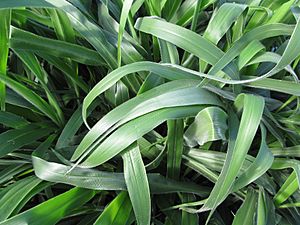Urochloa brizantha facts for kids
Quick facts for kids Urochloa brizantha |
|
|---|---|
 |
|
| Scientific classification | |
| Genus: |
Urochloa
|
| Species: |
brizantha
|
| Synonyms | |
|
|
Urochloa brizantha, also known as palisade grass, is a type of grass. It is often used as forage to feed farm animals like livestock.
This grass has many other common names around the world. Some English names include palisade signal grass, bread grass, Mauritius grass, and St. Lucia grass. In German, it's called Palisadengras. In Brazilian Portuguese, people call it braquiária, brizantão, or capim-marandu. In Spanish, it's known as zacate señal or pasto mulato.
Contents
What Palisade Grass Looks Like
This grass is a perennial, meaning it lives for more than two years. It can grow quite tall, usually between 1 and 2 meters (about 3 to 6.5 feet) high. It has roots that can go deep into the ground, up to 2 meters (about 6.5 feet) deep.
The leaves are green and can be very long, from 40 to 100 centimeters (about 16 to 39 inches). They are usually smooth or only slightly rough. The grass also has a special flower part called an inflorescence, which is like a cluster of small flowers. This part can be up to 20 centimeters (about 8 inches) long. It has several curved, crescent-shaped branches. Sometimes, these branches or the tiny flower parts can look purple.
Where Palisade Grass Grows
Palisade grass originally comes from tropical and southern Africa. However, people have purposely planted it in many other parts of the world. This includes places like South America and the Pacific islands.
It is a very important grass in Brazil, where it covers a huge area of more than 70,000 square kilometers (about 27,000 square miles). This grass grows well in grasslands and woodlands. It likes warm weather and can only handle a little bit of frost. It is also good at surviving dry periods, better than many other grasses that grow in warm climates.
Palisade grass can grow in many different types of soil. However, it does not do well in very poor soils. It often needs extra fertilizer to grow strong. Some types of palisade grass can also handle a bit of shade and even some mild flooding.
How People Use Palisade Grass
The main use for palisade grass is to feed livestock like cows. Farmers grow it in pastures where animals can graze on it. They also cut it to make hay and other fodder for animals. This grass is good because it can handle a lot of grazing without being damaged. It is also very nutritious and animals like to eat it. Even rabbits can eat this grass.
There are different types of palisade grass that farmers grow. Some popular ones are 'Marandú', 'Gigante', 'Insurgente', and 'Serengeti'.
Sometimes, farmers plant palisade grass together with other plants. These can be other grasses or special plants called legumes. Legumes help to make the soil healthier.
Besides feeding animals, palisade grass is also used as an ornamental plant in gardens. It can also help to stop soil from washing away, which is called erosion control. Interestingly, the seeds of this grass can also be eaten by humans.
Plant Health and Pests
Many animals, like baboons and chimpanzees, also eat palisade grass.
However, like all plants, palisade grass can get sick or be attacked by pests. It can get a leaf disease caused by a fungus called Rhizoctonia solani. It can also get rust, another type of fungus, and root rot from a bacterium. A fungus called Claviceps sulcata has also been found on this grass.
Insects can also cause problems. Shield bugs can damage the grass. But palisade grass is known for being strong against certain pests. For example, it is resistant to spittlebugs like Deois flavopicta, especially the 'Marandú' type. It is also resistant to leafcutter ants, which are ants that cut leaves to grow their food.
Keeping Animals Safe
Sometimes, if animals eat too much palisade grass, it can make them sick. This can cause problems like skin issues or make their faces swell. It can also affect how their stomachs work or make them have trouble moving. This happens because the plant has natural chemicals called saponins. These chemicals can build up in an animal's liver and cause damage. In some cases, this sickness can be very serious. Animals are more likely to get sick if they graze in fields that have not been eaten recently. Farmers need to manage their pastures carefully to keep their animals healthy.

